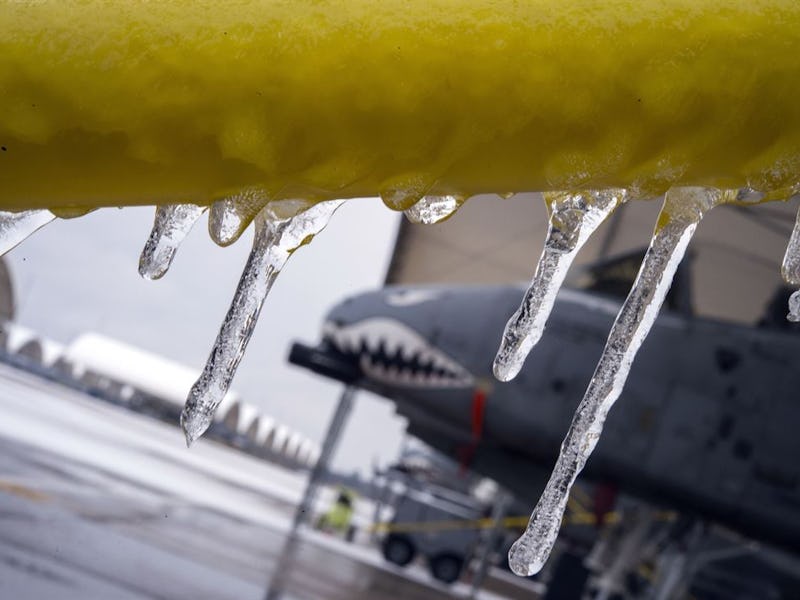Fecal Waste Falling From Canadian Sky Blamed on "Poopsicles" by Scientists
But the color of the poop doesn't add up.

Imagine going for a casual drive with the sunroof down, soaking up the rays, only to be splattered with poop raining from the sky. That’s reportedly what happened in Kelowna, British Columbia, to a woman named Susan Allen, who got a bad case of conjunctivitis (aka pink eye) after a strange, smelly, unexplained incident in late May. Now, as Canada’s air traffic control agency has officially denied its involvement in the incident and deemed the report a closed case, one alternative explanation remains increasingly likely: It may have been a poopsicle.
To Allan, the “popsicle” explanation is not likely to offer comfort or closure, especially in light of the response from Canada’s aviation authority. One explanation for the falling poop suggested that a plane illegally dropped it from an aircraft during flight, a move that the Canadian Aviation Regulations deems punishable. But on Friday, Transport Canada told The Guardian* in an email that it couldn’t have had anything to do with the falling poop because it wasn’t blue. Poop from airplanes is sometimes blue if the disinfectant Anotec — you know it from port-a-potties — is used in aircraft toilets.
You might also like: “Great, a Poop-Borne Swimming Pool Parasite Can Survive Chlorine Now”
“The department’s review has concluded that these incidents do not meet the description of blue ice and are therefore not aviation-related,” the email read.
"Blue ice" is the mixture of waste and blue disinfectant that was once notorious for leaking.
The only other explanation that’s been offered for the bizarre incident is the “poopsicle” theory put forth by University of British Columbia-Okanagan Earth and environmental sciences professor Robert Young, Ph.D., and corroborated by his colleague Bernie Bauer, Ph.D.. In an interview with local news agency Kelowna Capital News in June, Young explained that the poop had likely stemmed from a leak on the plane that slowly continued to freeze and grow as the plane reached higher, colder altitudes.
“If it started as being kind of a poopsicle on the bottom of a plane, then it could easily thaw and become liquid as it came down,” he said.
Further, Bauer said: “At low altitude, a bilge dump such as this would not have much time (distance) to disperse, and given the evident viscosity of such a mixture, it would not have dissipated into widespread drops (like raindrops). So it could have come down like a slurry of sorts.”
Siphon toilets don't use the blue liquid that was formerly used in planes.
The waste that came down on Allen’s car — as well as on the 17 others that had been poop-rained upon — was certainly not blue, which might suggest that Transport Canada can wash its hands of this mess guilt-free. But it’s worth noting that many airplanes no longer use the “chemical toilet blue water recirculated electric flush” method of waste disposal, preferring instead the “siphon toilet,” which uses water and gravity instead of Anotec to suck down poop into a holding tank.
The siphon toilet was patented in 1975 by an inventor named James Kemper after airlines found that carrying large amounts of Anotec was costly, detrimental to the plane body, and prone to leaking, forming dangerous blue balls of ice and poop that could fall from the sky and cause damage below. “Between 1979 and 2003, at least 27 wads of ‘blue ice’ fell from the sky in the United States alone, impacting with enough force to tear through roofs and smash cars,” Gizmodo reported in 2012, noting that for the past 30 years, the Kemper method has been the “industry standard.”
Siphon toilets sometimes still use a blue chemical called Skykem, according to a 2016 article by Travel and Leisure, and in January, Mike Miller, an Alaska Airlines maintenance operations instructor, [told Thrillist*](https://www.thrillist.com/travel/nation/how-airplane-toilets-work-dumping-waste): “You still have airplanes that were designed in the ‘60s and ‘70s.”
Miller added, “They’re still out there flying.”
In short, there doesn’t seem to be any requirement that blue disinfectant be used to flush or store airplane poop anymore, but the potential for blue ice is still out there. So, it’s not entirely clear whether Transport Canada’s excuse about blue ice holds up, but it could still very well be that the scientists’ theory about poopsicles, unlikely as it sounds, is the correct one.